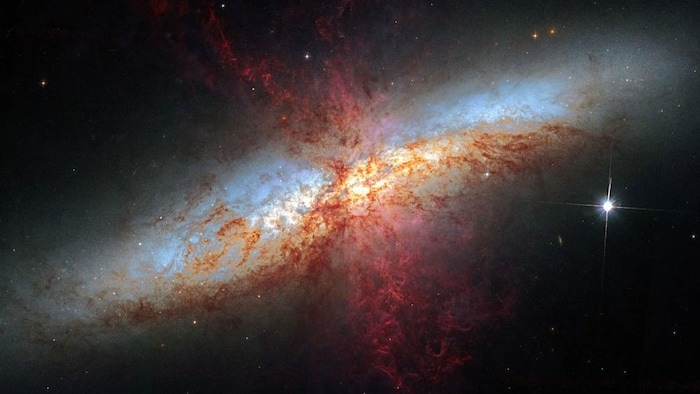Open in full screen mode Galactic winds are observed in nearby galaxies, such as M82, called a galaxy of the Cigar because of its shape. Agence France-Presse Speech synthesis, based on artificial intelligence, makes it possible to generate spoken text from 'a written text. Galaxies expel matter towards their immediate environment in the form of galactic winds, confirms an international study published by astrophysicists who have observed the phenomenon for the first time on a large sample of star clusters. The MUSE instrument of the Very Large Telescope (TGT) of the European Southern Observatory (ESO) allowed two years ago a first observation of this phenomenon on a galaxy seen from the edge. From the central region of its disk, two cones of gas charged with matter, which are galactic winds, escaped perpendicularly on each side . Now, we can generalize this observation to a large number of structures, says Nicolas Bouché, astrophysicist at the Lyon Astrophysical Research Center. The researcher, already at the heart of the observations made two years ago, is one of the main signatories of the study published in the journal Nature (New window) (in English), which concludes that the phenomenon of galactic winds seems common in massive galaxies.
Theoretical diagram of galactic winds. The background distribution (red) shows the gas fluxes of the galaxies detected by MUSE.
A host of scientists from mainly European institutes examined a sample of more than 160 galaxies, seen from the edge or from the front. Distant by more than 7 billion light years, they are witnesses to a Universe approximately half its current age.
The MUSE instrument, an integral field spectroscope, makes it possible to observe the signature of chemical elements, in extremely diffuse and low density clouds of matter.
Loading in progress
Emissions from the oil and gas sector: a cap in force by 2026
ELSEWHERE ON INFO: Emissions from the oil and gas sector: a cap in force by 2026
With a very long exposure time of the TGT telescope on the x27;sample of galaxies, MUSE made it possible to draw the shape of the winds escaping from them by detecting the signature of magnesium atoms.
These winds result from explosions of supernovae, massive stars which explode at the end of their life, at a rate ranging from one to ten per century depending on the type of galaxy, Nicolas Bouché explains to AFP.
Over millions of years, this adds up to form galactic winds, adds the researcher. These winds primarily escape from the galaxy through its central region, because this is where the greatest number of stars, and therefore supernovae, are concentrated.
< p class="StyledBodyHtmlParagraph-sc-48221190-4 hnvfyV">Rich in metals from supernovae, such as magnesium, these winds play a key role in the formation of stars within galaxies.
They can bring decrease in star formation, according to the researcher, by disrupting the environment where they form. They would also regulate the amount of material available to create these stars, because the more material carried away by galactic winds, the less there is for star formation.
The phenomenon appears widespread for the most common galaxies, with a mass of around 10 billion solar masses – lower than that of our Milky Way.
Next puzzle to solve: knowing how far these winds go, detected in the study up to distances of more than 30,000 light years. Compare with galactic halos, composed of a galaxy and the galactic cloud that surrounds it: these sets easily reach ten times this distance.
It is a question of knowing whether these winds and the matter they contain will fall back later, or escape (from the galaxy) to enrich the intergalactic environment, underlines Nicolas Bouché.
And this, on time scales that are not a breeze: they could be counted in billions of years .

